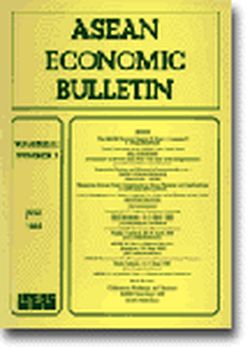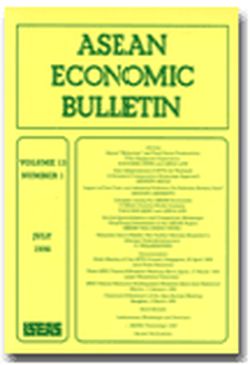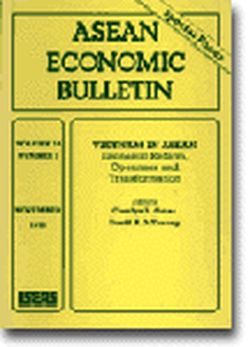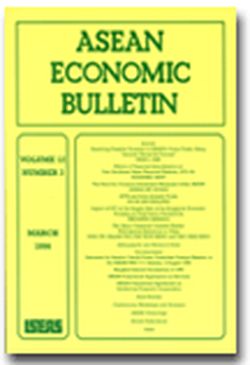ASEAN Economic Bulletin Vol. 12/1 (Jul 1995)

Date of publication:
July 1995
Publisher:
Institute of Southeast Asian Studies
Number of pages:
114
Code:
AE12/1
About the publication
Original Edition.
Original Edition
Original Edition
Contents
-
Preliminary pages, by Carolyn L Gates, author
-
The ASEAN Financial Sector: A Drag or a Leader? see abstractAn over-regulated and overprotected financial sector within individual countries of the Association of Southeast Asian Nations (ASEAN) have made the domestic financial institutions a drag on the less regulated and more competitive goods-producing sector, have made them less competitive abroad and have tended to drive finance business to offshore centres in this increasingly borderless world. The exception is Singapore. Apart from freeing their domestic financial sectors, ASEAN countries should aggressively develop their respective offshore financial centres on a competitive basis, and if necessary allow them to operate more freely from their commercial capitals and with adequate support services. The unprecedented investment flows and inflation pressures engendered by economic reforms must be dealt with by the pursuit of the right set of monetary and exchange rate policies and not by exchange controls. The lacklustre growth in non-trade related financial instruments and cross-border investments within ASEAN must be overcome by the deregulation of their domestic financial markets, by withholding tax reductions and by removing currency hedging restrictions.
-
Trade Diversion in an ASEAN Free Trade Area see abstractThe ASEAN Free Trade Area was formally established in January 1992 when the Singapore Declaration was endorsed. Resource allocation effects of such an integration has been a popular area of interest among trade economists since Viner (1950) raised doubts as to the positive nature of such a venture. The purpose of this article is to empirically estimate the negative effect, that is the trade diversion effect, on resource allocation among members of the Association of Southeast Asian Nations (ASEAN). Our results show that trade diversion is greatest in the Philippines amounting to 10 per cent of its 1990 exports to other ASEAN countries. This is followed by Singapore at 8 per cent, Thailand at 6 per cent, Malaysia at 5 per cent and Indonesia at 3 per cent. If we include trade creation, we conclude that there will be a net gain in welfare for Indonesia and Thailand and a net loss for Malaysia and Singapore. However, these are static effects, measuring the impact in the short term only. In the long term, it is possible that the positive dynamic effects of increased competition, economies of scale and the benefits of intra-industry trade far outweigh the short term effects.
-
A Postscript to AFTA's False Start: The Loss of Sovereignty Issue see abstractTo remedy the inherent defects of the AFTA Agreement in both substantive and implementation aspects, this article proposes: (1) amend the Agreementâs provision on the unilateral and highly discretionary manner of identifying products to be excluded from AFTAâs coverage, and (2) create an independent body that has the power to determine whether or not a member state has complied with its legal obligations in good faith (in accordance with the pacta sunt servanda principle). The ASEAN statesâ aversion to an independent adjudicatory body may be evaded by extricating the binding character of the said bodyâs decision, which means that a state found to have violated its AFTA obligations may either comply with or disregard the decision. Certainly, for this reason, the enforcement mechanism will again depend on that which is political. Notwithstanding the aforementioned, the unfavourable attitude of ASEAN states towards supranational bodies remains a puzzle as a number of them, if not all, have entered into agreements where supranational bodies are provided for to adjudicate on the rights not only of states parties but of private individuals vis-Ã -vis ASEAN states.
-
Enterprise Reform and Vietnam's Transformation to a Market-Oriented Economy see abstractRestructuring of industrial enterprises has long been an objective of reform in Vietnam, originating years before the formal establishment of the doi moi reform process. This article examines enterprise reform in the current context of Vietnamâs market-oriented transformation process. Specifically, it presents findings of ongoing research on Vietnamese state and private industrial enterprises, employing a âstructure-conduct-performanceâ framework from traditional industrial organization theory. The article concludes that Vietnamâs industrial enterprises are experiencing a âtransitional gapâ â between plan and market â and constructs two scenarios of diverging paths of enterprise reform: (1) enterprise transformation to market-oriented organization, incentives, and institutions; and (2) indeterminacy and medium-run enterprise adjustment under inherently unstable internal and external conditions.
-
Singapore Foreign Direct Investment in China: Features and Implications, by Lu Ding, contributor see abstractThis article presents the results of a survey of 95 Singapore companies and their 125 foreign direct investment (FDI) project packages in the Peopleâs Republic of China from 1990 to 1993. Several features are revealed: (1) small and medium-sized Singapore firms are actively involved in FDI in China; (2) the two provinces where Singapore Chinese business people have dialect advantages host more than 46 per cent of total investment; (3) the industrial distribution of the investment is heavily concentrated in construction and manufacturing projects with labour-intensive and flexible technologies. These findings suggest that small firms have their own competitive niche in the field of foreign direct investment. Singaporeâs managerial expertise and âsoftwareâ in property development, industrial park construction, doing business with multinational corporations, and handling technology transfers are in high demand in China. Both ethnic ties and governmental encouragement have favoured and influenced business ventures.
-
Policy Assignment on Money Supply: The Case of Indonesia in the 1980s, by Hiroyuki Taguchi, contributor see abstractIndonesia has taken a series of the most drastic de-regulatory steps on the financial sector among Asian developing countries since the 1980s. The financial deregulation has contributed to the accommodation of the loanable funds necessary for its intensive investment. Indonesia, on the other hand, has managed to curb inflation at the annual rate below double digits by controlling money supply. When we focus on the stance of monetary policy in the long-run view, investment requires the expansion of money supply, and price stability requires its contraction. Thus, the monetary policy in Indonesia has been on a double-edged sword. This article describes how Indonesia has struggled with âdouble-trackâ targets on monetary policy, and evaluates its policy performance from the viewpoint of its workability and consistency.
-
DOCUMENTATION: Second APEC Finance Ministers Meeting, Bali, Indonesia, 15-16 April 1995, Joint Ministerial Statement
-
DOCUMENTATION: Second ASEAN Economic Ministers Retreat, Phuket, Thailand, 28-29 April 1995, Joint Press Statement
-
DOCUMENTATION: ASEAN-EU Senior Officials Meeting, Singapore, 2-4 May 1995, Joint Press Statement
-
DOCUMENTATION: ASEAN Meeting on the Management of Transboundary Pollution, Kuala Lumpur, 14-17 June 1995, Joint Press Statement
-
DOCUMENTATION: ASEAN Co-operation Plan on Transboundary Pollution
-
BOOK REVIEW: India’s Economy at the Midnight Hour: Australia’s India Strategy. By East Asian Analytical Unit, Department of Foreign Affairs and Trade
-
BOOK REVIEW: The New World Trading System: Readings, OECD Documents, by Rolf J Langhammer, contributor
-
BOOK REVIEW: Creating Economic Opportunities: The Role of Labour Standards in Industrial Restructuring. By Werner Sengenberger and Duncan Campbell
-
Conferences, Workshops, and Seminars; ASEAN Chronology 1995; Recent Publications






